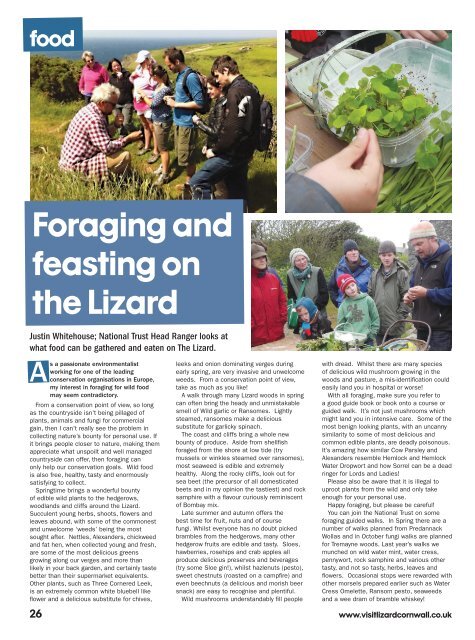Lizard Guide
You also want an ePaper? Increase the reach of your titles
YUMPU automatically turns print PDFs into web optimized ePapers that Google loves.
food<br />
Foragingand<br />
feastingon<br />
the <strong>Lizard</strong><br />
Justin Whitehouse; National Trust Head Ranger looks at<br />
what food can be gathered and eaten on The <strong>Lizard</strong>.<br />
As apassionate environmentalist<br />
working for one of the leading<br />
conservation organisations in Europe,<br />
my interest in foraging for wild food<br />
may seem contradictory.<br />
From aconservation point of view, so long<br />
as the countryside isn’t being pillaged of<br />
plants, animals and fungi for commercial<br />
gain, then Ican’t really see the problem in<br />
collecting nature’s bounty for personal use. If<br />
it brings people closer to nature, making them<br />
appreciate what unspoilt and well managed<br />
countryside can offer, then foraging can<br />
only help our conservation goals. Wild food<br />
is also free, healthy, tasty and enormously<br />
satisfying to collect.<br />
Springtime brings awonderful bounty<br />
of edible wild plants to the hedgerows,<br />
woodlands and cliffs around the <strong>Lizard</strong>.<br />
Succulent young herbs, shoots, flowers and<br />
leaves abound, with some of the commonest<br />
and unwelcome ‘weeds’ being the most<br />
sought after. Nettles, Alexanders, chickweed<br />
and fat hen, when collected young and fresh,<br />
are some of the most delicious greens<br />
growing along our verges and more than<br />
likely in your back garden, and certainly taste<br />
better than their supermarket equivalents.<br />
Other plants, such as Three Cornered Leek,<br />
is an extremely common white bluebell like<br />
flower and adelicious substitute for chives,<br />
leeks and onion dominating verges during<br />
early spring,are very invasive and unwelcome<br />
weeds. From aconservation point of view,<br />
take asmuch as you like!<br />
Awalk through many <strong>Lizard</strong> woods in spring<br />
can often bring the heady and unmistakable<br />
smell of Wild garlic or Ransomes. Lightly<br />
steamed, ransomes make adelicious<br />
substitute for garlicky spinach.<br />
The coast and cliffs bring awhole new<br />
bounty of produce. Aside from shellfish<br />
foraged from the shore at low tide (try<br />
mussels or winkles steamed over ransomes),<br />
most seaweed is edible and extremely<br />
healthy. Along the rocky cliffs, look out for<br />
sea beet (the precursor of all domesticated<br />
beets and in my opinion the tastiest) and rock<br />
samphire with aflavour curiously reminiscent<br />
of Bombay mix.<br />
Late summer and autumn offers the<br />
best time for fruit, nuts and of course<br />
fungi. Whilst everyone has no doubt picked<br />
brambles from the hedgerows, many other<br />
hedgerow fruits are edible and tasty. Sloes,<br />
hawberries, rosehips and crab apples all<br />
produce delicious preserves and beverages<br />
(try some Sloe gin!), whilst hazlenuts (pesto),<br />
sweet chestnuts (roasted on acampfire) and<br />
even beechnuts (a delicious and morish beer<br />
snack) are easy to recognise and plentiful.<br />
Wild mushrooms understandably fill people<br />
with dread. Whilst there are many species<br />
of delicious wild mushroom growing in the<br />
woods and pasture, amis-identification could<br />
easily land you in hospital or worse!<br />
With all foraging,make sure you refer to<br />
agood guide book or book onto acourse or<br />
guided walk. It’s not just mushrooms which<br />
might land you in intensive care. Some of the<br />
most benign looking plants, with an uncanny<br />
similarity to some of most delicious and<br />
common edible plants, are deadly poisonous.<br />
It’s amazing how similar Cow Parsley and<br />
Alexanders resemble Hemlock and Hemlock<br />
Water Dropwort and how Sorrel can be adead<br />
ringer for Lords and Ladies!<br />
Please also be aware that it is illegal to<br />
uproot plants from the wild and only take<br />
enough for your personal use.<br />
Happy foraging,but please be careful!<br />
Youcan join the National Trust on some<br />
foraging guided walks. In Spring there are a<br />
number of walks planned from Predannack<br />
Wollas and in October fungi walks are planned<br />
for Tremayne woods. Last year’s walks we<br />
munched on wild water mint, water cress,<br />
pennywort, rock samphire and various other<br />
tasty,and not so tasty,herbs, leaves and<br />
flowers. Occasional stops were rewarded with<br />
other morsels prepared earlier such as Water<br />
Cress Omelette, Ransom pesto, seaweeds<br />
and awee dram of bramble whiskey!<br />
26 www.visitlizardcornwall.co.uk



